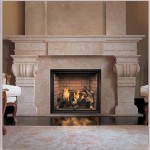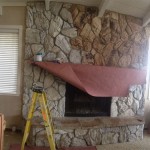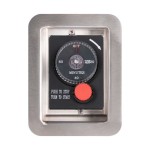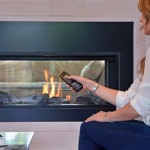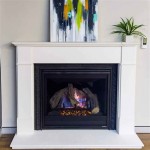How Big Is A Fireplace? Understanding Fireplace Dimensions
Determining the ideal size of a fireplace is a crucial aspect of both new construction and renovation projects. The dimensions directly impact several factors, including heating efficiency, aesthetic appeal, and overall functionality within the living space. A fireplace that is too small may not provide adequate warmth, while an overly large fireplace could dominate the room and potentially create safety concerns. Consequently, a careful consideration of various factors is required to ascertain the appropriate size for a specific setting.
The dimensions of a fireplace are generally described using three primary measurements: width, height, and depth. The width refers to the horizontal measurement across the opening of the fireplace, usually taken at the front. The height represents the vertical measurement from the hearth to the top of the firebox opening. Finally, the depth indicates the distance from the front of the firebox to the back wall. Each of these dimensions plays a critical role in the overall performance and appearance of the fireplace.
Key Point 1: Factors Influencing Fireplace Size Selection
Several variables influence the optimal size of a fireplace. These include the size of the room, the fireplace’s intended use (primary heating source versus occasional ambiance), and the preferred aesthetic. Larger rooms, naturally, necessitate larger fireplaces to effectively distribute heat. Conversely, smaller rooms may benefit from a smaller fireplace, which reduces the risk of overheating and overwhelming the space. If the fireplace is solely for aesthetic purposes, the size can be more flexible, prioritizing visual appeal over heating capacity.
The type of fuel used also dictates the size. Wood-burning fireplaces typically require larger fireboxes to accommodate sufficient fuel and ensure proper airflow. Gas fireplaces, on the other hand, can be smaller, as gas burns more efficiently and produces less ash. The size requirements for electric fireplaces are primarily determined by the desired visual effect, as they do not rely on combustion for heat generation.
Building codes and safety regulations also play a significant role in determining fireplace dimensions. Local ordinances often specify minimum and maximum firebox sizes, as well as clearance requirements from combustible materials. Adherence to these regulations is essential to ensure the safety and legality of the fireplace installation. Consulting with a qualified building inspector during the planning stages is highly recommended.
Key Point 2: Standard Fireplace Dimensions and Variations
While custom fireplace designs are common, certain standard dimensions exist that serve as a useful starting point. A typical residential wood-burning fireplace might have a width of 36 to 48 inches, a height of 28 to 36 inches, and a depth of 20 to 24 inches. These dimensions allow for a reasonably sized fire and adequate airflow for combustion. However, these are merely guidelines, and significant variations are possible depending on the specific design and manufacturer.
Gas fireplaces frequently have smaller dimensions than wood-burning models. A common gas fireplace might measure 24 to 36 inches in width, 20 to 30 inches in height, and 12 to 18 inches in depth. The reduced depth is made possible by the more efficient burning process of gas, which requires less space for combustion and ash accumulation. Furthermore, ventless gas fireplaces can be even more compact, as they do not require a chimney or flue.
Electric fireplaces offer the greatest flexibility in terms of size and shape. They can range from small, wall-mounted units to large, elaborate installations that mimic traditional wood-burning fireplaces. The primary factor determining the size of an electric fireplace is the display area, which showcases the simulated flames. The dimensions of the heating element are typically less significant, as electric fireplaces rely on resistance heating rather than combustion.
Key Point 3: Measuring an Existing Fireplace
When replacing or renovating an existing fireplace, accurate measurements are essential. Measuring the width, height, and depth of the firebox is the first step. The width should be measured across the front of the opening, from one side to the other. The height should be measured from the hearth to the top of the firebox opening. The depth should be measured from the front of the firebox to the back wall.
In addition to the firebox dimensions, it is also important to measure the overall dimensions of the fireplace surround or mantel. This includes the width, height, and depth of the entire structure. These measurements are crucial for ensuring that the new fireplace insert or surround fits properly within the existing space. Accurate measurements can prevent costly mistakes and ensure a professional-looking installation.
Consider the chimney flue size when replacing a wood-burning fireplace. The flue must be adequately sized to properly vent smoke and combustion gases. An undersized flue can lead to poor drafting, resulting in smoke entering the room. Consult with a qualified chimney sweep to determine the appropriate flue size for the new fireplace. The correct flue size is determined in correlation both with the size of the fireplace opening and the height of the chimney itself. A skilled chimney sweep can provide appropriate installation, safety, and building code expertise.
Finally, it is advisable to take multiple measurements at different points to account for any irregularities or variations in the fireplace structure. This is particularly important in older homes, where the fireplace may not be perfectly square or level. Providing accurate and comprehensive measurements to a fireplace installer or supplier will ensure that the new fireplace is the correct size and fits properly within the existing space.
Ultimately, the optimal size of a fireplace depends on a complex interplay of factors. By carefully considering the room size, intended use, fuel type, building codes, and aesthetic preferences, it is possible to select a fireplace that is both functional and visually appealing. Thorough measurement and professional consultation are further essential steps in ensuring a successful fireplace installation or renovation.

The Proper Way To Measure Dimensions Of A Fireplace

Fireplace Dimensions Standard Sizes Explained

Ed Gordon

Fireplace Dimensions Gas Electric Outdoor

How Big Should My Fireplace Be Stylish Fireplaces

15 Fireplaces So Large Grand You Can Almost Walk Into Them Designed French Fireplace Home

Big Rumfords

How Big Should My Fireplace Be Stylish Fireplaces

Big Rumfords
How To Start A Fireplace Fire 2 Safe And Easy Methods
Related Posts


